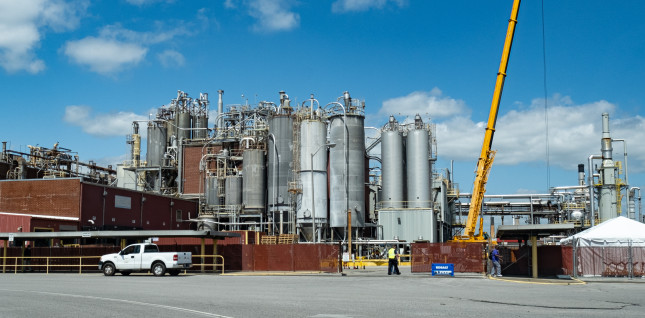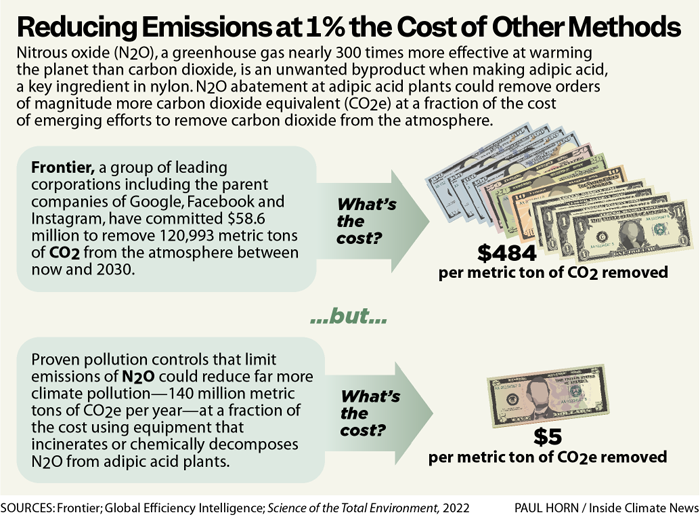-
A U.S. Nonprofit Aims to Reduce Emissions of a Super Climate Pollutant from Chemical Plants in China
May 25, 2023 By Philip McKennaA new initiative by the Climate Action Reserve, a nonprofit organization based in Los Angeles, could play a significant role in curbing emissions of a potent climate pollutant from chemical plants in China while filling a gap in international climate agreements and China’s environmental regulations.
However, a former industry insider who worked for chemical producers decades ago when they voluntarily reduced their emissions of the pollutant nitrous oxide, said the new initiative would unfairly reward bad actor companies who continued to pollute, long after low-cost pollution controls were widely adopted by their peers.
China’s Nitrous Oxide Conundrum
Nitrous oxide is a potent greenhouse gas that is nearly 300 times more effective at warming the planet than carbon dioxide on a pound-for-pound basis. It is also the leading, ongoing source of atmospheric ozone depletion after more harmful chemicals were banned in recent decades under the Montreal Protocol, an international environmental agreement.
The pollutant is an unwanted byproduct of the manufacturing of adipic acid, a key ingredient in the production of nylon 6,6, a highly durable plastic used in airbags, seat belts, and carpeting.
Most—but not all—adipic acid plants outside of China installed pollution controls in the 1990s that eliminate 99 percent of nitrous oxide emissions. It can be reduced from adipic acid plants at a cost of approximately $5 per metric ton of carbon dioxide equivalent, according to a study published last year in the journal Science of the Total Environment, making it one of the least expensive ways to combat climate change. Emerging efforts to remove carbon dioxide from the atmosphere, by comparison, can cost hundreds of dollars per ton.
“In terms of a cost effectiveness perspective, this is probably one of the lowest costs, both in terms of economic costs, and also in administrative costs of reducing greenhouse gas emissions,” said Jiang Lin, a China energy policy expert at the University of California Berkeley, and lead author of the 2022 study, noting that there are a limited number of adipic acid plants worldwide with significant nitrous oxide emissions.
Eleven adipic acid plants in China and one in the United States emitted approximately 500,000 metric tons of nitrous oxide in 2021, equal to 141 million metric tons of carbon dioxide or the annual greenhouse gas emissions of 31 million automobiles, according to a recent report by Global Efficiency Intelligence, an industrial decarbonization research and consulting firm based in Tampa.
Solutions for this Super Climate Pollutant?
The Climate Action Reserve seeks to establish a “protocol” or rules for verifying nitrous oxide emissions and for issuing emissions reduction credits from chemical plants in China. As the Chinese chemical companies reduce their nitrous oxide emissions, other companies anywhere in the world could then purchase the credits to help offset their own emissions as part of their own “net zero” targets or other voluntary emissions reduction goals.
Another policy measure that could reduce nitrous oxide emissions would be an expansion of the Montreal Protocol, an international environmental agreement, to include nitrous oxide. The agreement originally focused on curbing ozone depleting pollutants that were responsible for creating the ozone hole, but was expanded in 2016 to include hydrofluorocarbons, which do not harm ozone, but are potent greenhouse gases.
“That does create a basis, or a good example, of how the Montreal Protocol could be further amended, potentially to address nitrous oxide,” Kate Logan, associate director of climate at the Asia Society Policy Institute, a Washington think tank, said of nitrous oxide, noting that it is both an ozone depleter and a potent greenhouse gas.
Ascend Performance Materials, a chemical company that operates an adipic acid plant near Pensacola, Florida, recently began earning emissions reduction credits and selling them to others, based on a similar protocol that the Climate Action Reserve developed for U.S. plants in 2020.
Craig Ebert, president of the Climate Action Reserve, said the new protocol could have a significant impact at little cost.
“Humanity is missing its climate targets horribly, and this is a way to get a lot of bang for our buck,” Ebert said. “If we get enough plants to adopt, it could lead to tens of millions of tons [of carbon dioxide equivalent] annually, if not more, being taken out of the atmosphere.”
The new protocol seeks to thread a needle by incentivizing Chinese chemical companies to slash their nitrous oxide emissions without overpaying them.
Phil McKenna reports on non-CO2 greenhouse gases for Inside Climate News and recently spoke at a China Environment Forum panel on nitrous oxide emissions from chemical plants in China.
Sources: Frontier Climate, Global Efficiency Intelligence, Science Express, Science of the Total Environment
Lead Photo Credit: Ascend Performance Materials’ adipic acid plant near Pensacola, Florida, used with permission courtesy of Agya Aning/Inside Climate News.
 A Publication of the Stimson Center.
A Publication of the Stimson Center.





